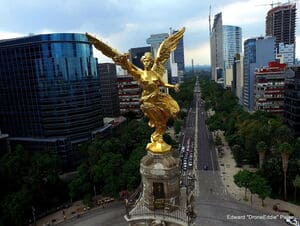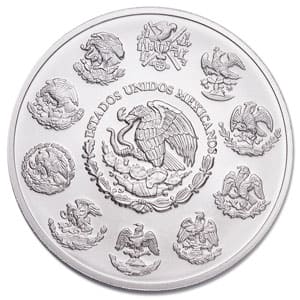Legends on the Libertad
Few coinage stories are as captivating as those whose designs offer a beautiful mix of symbols celebrating history and heritage. Back in 1982, Mexico issued the world’s first silver bullion, the Libertad. That’s a noteworthy milestone. Canada and South Africa were the only countries issuing bullion at that time, and gold at that!
Unlike those two countries, and others that began to issue silver bullion struck with annually changing designs, Mexico remained faithful to its origin symbols. Let’s take a look.
Victoria, Angel of Independence
 Angel of Independence statue, Mexico City
Angel of Independence statue, Mexico CityMexico chose the Roman goddess, Victory, to honor the complex series of revolts that marked the 11-year war for independence from Spanish colonial rule. To commemorate the centennial of that war’s start, in 1910 it installed a 22-foot victory column in its capital, Mexico City. On the top, it placed Winged Victory, a seven-ton bronze statue gilded in 24k gold leaf. In Victoria’s raised right hand is the laurel wreath of self-governance. In her left, is a symbolic broken chain of servitude.
In 1921, the centennial of the war’s end, the national mint of Mexico tasked engineer and engraver Emilio del Moral to design a 50 Pesos coin – a centenario in both silver and gold – with the winged Angel of Independence at its center. From 1921 to 1931, the coins were issued regularly. Production was restarted in 1943 to meet demand for gold coins as countries around the globe stood on the precipice of World War II. Gold coins issued from 1949 to 1972, have a 1947 date mark.
In 1982, the centenario’s obverse design made a new appearance as the reverse motif of the silver Libertad. It remained unchanged through 1995. In 1996, a slight modification resulted in a ¾ view of the Angel of Independence and a size increase of 4 mm to a 40 mm diameter for the bullion issued in 99.9% fine silver.
Popo and Itza: A Love Story
Of interest to historians and hikers alike, is the Libertad’s background design on what is considered the coin’s reverse. Behind the Angel of Independence is a tribute to Mexico City’s origins as the seat of the Aztec Empire established in 1325, plus the natural beauty found on the mountain range at its outskirts.
 Iztaccíhuatl (left) and Popocatepetl (right), two of the highest volcanoes in Mexico
Iztaccíhuatl (left) and Popocatepetl (right), two of the highest volcanoes in MexicoNow for the Aztec legend. It tells the story of ill-fated lovers, a quest, a lie, a broken heart, death and finally, eternal devotion. On the coin’s field, at the left, is the now-dormant volcano named for Princess Iztaccihuatl (ees-TAHK-ee-wahtl) and sometimes referred to as the Sleeping Woman. To the right, is the still-active volcano named for her warrior lover, Popocatetetl (popo-cata-petal).
While Popo was away at war, a jealous suitor told Itza he had died in combat. Grief-striken, Izta cried until her heart stopped. Upon his return, Popo built her a massive tomb and then knelt beside her with a smoking torch to watch over her for eternity. Centuries passed. Earth covered their figures. Snow fell. To this day, when Popo erupts, the Aztec legends says it’s because his pain still burns deep within his heart.
Golden Eagle, Writhing Snake
 Libertad’s obverse, featuring the country’s national bird
Libertad’s obverse, featuring the country’s national birdMexico’s Aztec’s history is also symbolized on the Libertad’s obverse, which features the country’s national bird, the golden eagle. Perched atop a prickly cactus, it wrestles a rattlesnake for dominance. Eventually, this Aztec symbol came to be Mexico’s coat of arms. In 2000, the silver Libertad’s obverse changed to feature the current national coat of arms as the central motif, surrounded by 10 past versions of the golden eagle on Mexican coins.
After an existence of nearly 170 years, the Aztec Empire fell to Spanish conquistador Hernán Cortés. According to another Aztec legend, a curse was placed on a treasure chest filled with gold coins given to Cortés to get him to stop the massacre of the indigenous population. He didn’t and to this date, the gold was never found. Collectors can recall this lost piece of history with a handsomely detailed commemorative round in one troy ounce of silver called the Cursed Aztec. At its center is the sun god Tonatiuh. You can also find Tonatiuh, the golden eagle and other Aztec referenced on this coin set from Mexico.
Whether the silver Libertad or Mexican pesos, this country’s rich Aztec heritage is ready for coin collectors. Share with us below what you’ve added to your collection, or what you are looking for!



